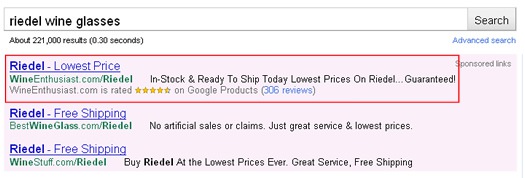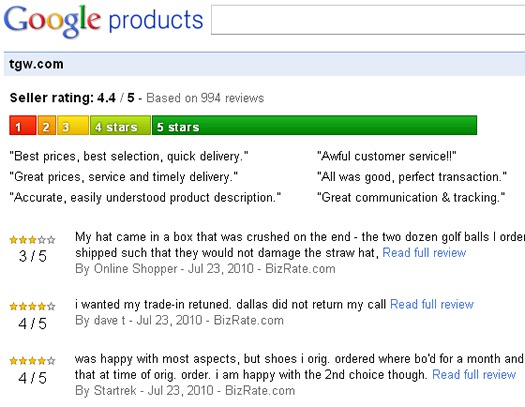If the movie 2001: A Space Odyssey were released in 2010 versus 1968, the classic line above may have been followed by a click-through to read reviews. Let’s find out why. Over the past year, Google AdWords has introduced a number of ad extensions that enable advertisers to provide additional information about their businesses and products.
For example, product extensions, location extensions, ad sitelinks, and phone extensions are all now available to advertisers. Each ad extension provides valuable information along with the paid search advertisement in question, such as phone numbers, links deeper into a website, addresses, and product visuals and pricing. In my experience with helping clients with paid search, I’ve definitely seen ad extensions make an impact. It’s easy to understand why. When you are dealing with such a limited space for your paid search ads, adding visuals and other valuable information can really make those ads stand out (and help you build credibility).
The Latest Ad Extension – Seller Rating Extensions
In late June, AdWords implemented seller rating extensions, which can show up along with paid search ads when people are searching for product information. Seller rating extensions include the merchant star rating for advertisers that are highly rated on Google Product Search. If you’re not familiar with Google Product Search, it’s an area of Google where shoppers can search products to compare prices, find reviews, and link to merchant websites to ultimately buy the products they are interested in. By setting up a Google Merchant Account, you can supply Google with a feed containing your product information. Once you set up the feed, shoppers can find your products via Google Product Search (and via your paid search ads by implementing product extensions).
If you run an e-commerce site and you haven’t set up a Google Merchant Account, you should – but only after reading the rest of my post. 🙂 That said, although I think it’s important to set up a Google Merchant Account, it’s not required for seller rating extensions to work. I’ll provide more information about seller rating extension requirements later in this post.
How Seller Rating Extensions Can Impact Paid Search Performance
They say a picture is worth a thousand words. I’ve provided two screenshots below of seller rating extensions showing up in the top three paid search listings (directly above the organic listings). How well do you think listings without seller rating extensions will perform when they are sitting next to two advertisers with seller rating extensions? Like I said earlier, minor enhancements to an ad can make a big difference in such a limited space.


Needless to say, having selling rating extensions show up with your ads can be an important element for building credibility and increasing click-through. Unless you’re a big brand, there’s a good chance that people searching for products don’t know your company and what other consumers think about your business. When these people are provided with a series of advertisements, which one will they click through? It very well could be the one showing a highly rated merchant, especially since they can click through to read the reviews on Google Product Search.
Unfortunately for advertisers without seller rating extensions, their ads could pale in comparison. And to make matters worse, advertisers without seller rating extensions might actually be excellent merchants with customers that love buying from them. There’s just a lack of reviews for the merchant… More on that soon. By the way, here is the page that shoppers can view once they click through to read the reviews. Shoppers have the ability to filter reviews by rating, topic, or by source.

How to Get Seller Rating Extensions
Now that you’ve seen seller rating extensions in action, I bet you’re wondering how to get them showing up along with your paid search ads. Good question, and the answer could mean some work for you. But that could be good for your business and I’ll explain why soon. First, I’ll list the criteria you’ll need to meet in order for seller rating extensions to show up with your ads.
Here are the requirements for having seller rating extensions show up (directly from the AdWords Help Center):
- Your campaign must be opted in to Google search.
- Your campaign must be targeted to the US only.
- Your business must have at least 30 unique reviews and a rating of four stars or above on Google Product Search.
The first two are easy…and the third one isn’t so easy (and is partly out of your control). Having customer reviews can help your business on several levels, and seller rating extensions is just one more reason to ensure your customers are reviewing your products. By the way, if you’re wondering how you are charged for seller rating extensions, Google only charges for clicks on the standard ad (when someone clicks the title of your paid search ad). If someone clicks through the ad extension to read reviews, you are not charged.
Where Reviews Come From and What You Can Do To Impact Your Rating Extensions
Google Product Search aggregates reviews from a number of sources, so there’s not just one place you can drive customers to in order to review your products. The AdWords Help Center lists several sources of reviews, including Reseller Ratings, Bizrate, ReviewCentre.com, Viewpoints, and Google Checkout reviews. You can perform some searches on Google Product Search and check the reviews to see other sources Google taps into for reviews. For example, I saw pricegrabber.com, Yahoo, epinions, MrRebates.com, etc. Once you understand the various sources, it’s time to get more reviews.
Getting More Reviews (Ethically)
I highly recommend mapping out a communication plan for ensuring that your customers know they can review your products. There are times that people simply don’t know they can review your products, and where to actually publish their reviews. Your customers might love your products and service, but just need a last nudge to write a review.
There are several ways you can communicate with your customers about the review process. You can include a message in the confirmation email after they purchase a product, you can send a follow up email explaining that they can review your products, you can use your Facebook page and Twitter account to remind followers and fans that they can review your products, etc. If you have a call center, then you can also have your representatives let customers know that they can review their latest purchase.
I think you’ll be surprised to see how many customers are willing to write reviews for you once they know that they can, along with where to publish those reviews. Again, you need 30 reviews, and not 500. If you create a solid communication plan, this shouldn’t be a problem. Also, once you create your communication plan and build enough reviews, let it keep running. Have it become a standard part of the process for your business. You could end up with hundreds or thousands of reviews over time, and that can only help your efforts.
Show Your Stars, Increase Click-Through, and Boost Sales With Seller Rating Extensions
The more I work with ad extensions in Google AdWords, the more I see how minor additions to an advertisement can impact click-through and sales. Seller Rating Extensions are the latest to hit Google.com and should be part of the paid search equation for companies running e-commerce websites. Don’t let stars and ratings from competitors overshadow your ads. You can have those stars too. You just need to meet the requirements.




![AI Overviews: We Reverse-Engineered Them So You Don't Have To [+ What You Need To Do Next]](https://www.searchenginejournal.com/wp-content/uploads/2025/04/sidebar1x-455.png)